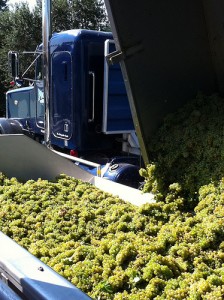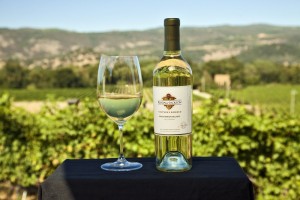Harvest 2011: Making White Wine
Harvest is in full swing at Kendall-Jackson. We have been receiving grapes non-stop for a number of days now, so I wanted to give some insight on what a working winery does once the fruit arrives.
 This year Sauvignon Blanc and Chardonnay grapes were the first to arrive. And at the winery in Geyserville, boy do we handle a lot of them. Upon arrival these white grapes are immediately loaded into bladder-type presses that use pneumatic pressure to gently squeeze the grapes to release the juice. This juice is allowed to settle for 24-48 hours so that clean juice is separated from the heavy solids (mostly pulp – sometimes referred to as the gross lees).
This year Sauvignon Blanc and Chardonnay grapes were the first to arrive. And at the winery in Geyserville, boy do we handle a lot of them. Upon arrival these white grapes are immediately loaded into bladder-type presses that use pneumatic pressure to gently squeeze the grapes to release the juice. This juice is allowed to settle for 24-48 hours so that clean juice is separated from the heavy solids (mostly pulp – sometimes referred to as the gross lees).
Next, we use a technique called racking (removing the clear juice from a valve situated above the heavy solids layer) to move the juice to a clean vessel. We then inoculate the juice with wine yeast and fermentation begins.
For Sauvignon Blanc we almost always ferment in stainless steel at cold temperatures to preserve delicate aromatics. On the Chardonnay side, we wait 24 hours after the inoculation and then move the wine into 59 gallon (225 liter) barrels for barrel fermentation.
These are two popular ways to ferment white grape juice and result in very different wine styles. The clean, crisp and tart flavors of a Sauvignon Blanc are a result of the cold, stainless-steel fermentation; meanwhile the round, viscous and buttery characters of a barrel-fermented Chardonnay are the result of this fermentation style.
By making choices like this the winemaker influences the type of wine he or she aims to create.
Once the juice is inoculated and starts fermenting, we monitor it closely by taking a sugar and temperature reading every day. This way winemakers can keep track of progress, know if the fermentation is healthy or struggling, and know when the fermentation is finished.
 Fermenting wine needs room for foaming and expansion because of carbon dioxide gas that is released as yeast converts sugar into alcohol. Once all the sugar has been consumed, whether in stainless or barrels, we top off the wine up to protect it from oxidation. We will keep the wine in topped containers at all times until we bottle it for you, our valued consumers.
Fermenting wine needs room for foaming and expansion because of carbon dioxide gas that is released as yeast converts sugar into alcohol. Once all the sugar has been consumed, whether in stainless or barrels, we top off the wine up to protect it from oxidation. We will keep the wine in topped containers at all times until we bottle it for you, our valued consumers.
But white wine is only half of what we do at the winery. Tune in next week for a discussion of red fermentation.
Cheers!



